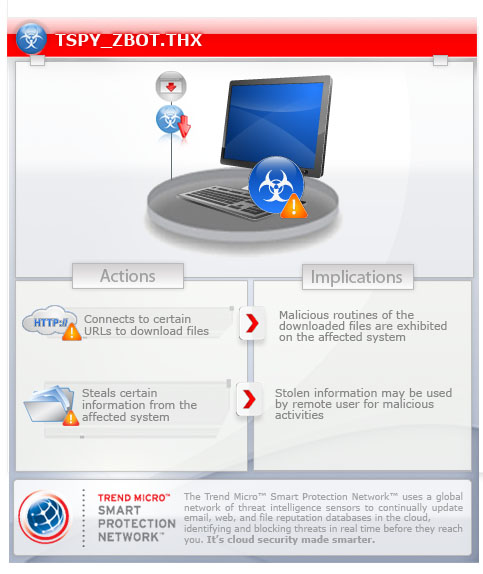TSPY_ZBOT.THX
PWS:Win32/Zbot (Microsoft), Win32/Spy.Zbot.YW trojan (ESET)
Windows 2000, Windows XP (32-bit and 64-bit), Windows Server 2003, Windows Vista (32-bit and 64-bit), Windows 7 (32-bit and 64-bit)


Threat Type: Spyware
Destructiveness: No
Encrypted:
In the wild: Yes
OVERVIEW
This is the Trend Micro detection for KINS Trojan, dubbed as the next ZeuS by media reports. Similar to ZeuS/ZBOT, it downloads configuration file and steals online banking credentials. However, it uses a different packer and has anti-debugging and anti-analysis routines.
To get a one-glance comprehensive view of the behavior of this Spyware, refer to the Threat Diagram shown below.

This spyware arrives on a system as a file dropped by other malware or as a file downloaded unknowingly by users when visiting malicious sites.
It modifies registry entries to disable the Windows Firewall settings. This action allows this malware to perform its routines without being deteted by the Windows Firewall.
As of this writing, the said sites are inaccessible.
It deletes the initially executed copy of itself.
TECHNICAL DETAILS
Arrival Details
This spyware arrives on a system as a file dropped by other malware or as a file downloaded unknowingly by users when visiting malicious sites.
Installation
This spyware drops the following copies of itself into the affected system:
- %Application Data%\{random folder name 1}\{random file name 1}.exe
(Note: %Application Data% is the current user's Application Data folder, which is usually C:\Documents and Settings\{user name}\Application Data on Windows 2000, XP, and Server 2003, or C:\Users\{user name}\AppData\Roaming on Windows Vista and 7.)
It drops the following files:
- %Application Data%\{random folder name 2}\{random file name 2}.{random file extension} - contains encrypted stolen information
(Note: %Application Data% is the current user's Application Data folder, which is usually C:\Documents and Settings\{user name}\Application Data on Windows 2000, XP, and Server 2003, or C:\Users\{user name}\AppData\Roaming on Windows Vista and 7.)
It creates the following folders:
- %Application Data%\{random folder name 1}
- %Application Data%\{random folder name 2}
(Note: %Application Data% is the current user's Application Data folder, which is usually C:\Documents and Settings\{user name}\Application Data on Windows 2000, XP, and Server 2003, or C:\Users\{user name}\AppData\Roaming on Windows Vista and 7.)
It adds the following mutexes to ensure that only one of its copies runs at any one time:
- Global\{GUID}
- Local\{GUID}
It injects threads into the following normal process(es):
- explorer.exe
Autostart Technique
This spyware adds the following registry entries to enable its automatic execution at every system startup:
HKEY_CURRENT_USER\Software\Microsoft\
Windows\CurrentVersion\Run
{random file name 1}.exe = "%Application Data%\{random folder name 1}\{random file name 1}.exe"
Other System Modifications
This spyware adds the following registry keys:
HKEY_CURRENT_USER\Software\Microsoft\
{random}
It adds the following registry entries:
HKEY_CURRENT_USER\Software\Microsoft\
{random}
{random string} = "{random hex values}"
It modifies the following registry entries to disable the Windows Firewall settings:
HKEY_LOCAL_MACHINE\SYSTEM\CurrentControlSet\
Services\SharedAccess\Parameters\
FirewallPolicy\StandardProfile\AuthorizedApplications\
List
%Windows%\explorer.exe = "%Windows%\explorer.exe:*:Enabled:Windows Explorer"
Download Routine
This spyware connects to the following URL(s) to download its configuration file:
- https://{BLOCKED}linker.net/temperdata/sdg12s.bin
- http://{BLOCKED}mmj.com/cfg.bin
As of this writing, the said sites are inaccessible.
Information Theft
This spyware gathers the following data:
- Data on Cookie files (URLs)
- Email-related information such as account names, email addresses, passwords, server data, and server port
Other Details
This spyware connects to the following URL(s) to check for an Internet connection:
- http://www.google.com/webhp
It deletes the initially executed copy of itself
NOTES:
The configuration file may contain URLs where it downloads an updated copy of itself and where it sends its gathered information. It may also contain URLs of its target online banking and finance-related sites from where it steals the information.
Here are some of its anti-analysis techniques.
- It checks for the following files:
- C:\TOOLS\execute.exe
- C:\popupkiller.exe
- SbieDll.dll
- \\.\HGFS
- \\.\NPF_NdisWanIp
- \\.\VboxGuest
- It checks for the following registry keys:
- It checks for the following mutex:
- Frz_State
HKEY_LOCAL_MACHINE\Software\Wine
HKEY_CURRENT_USER\Software\Wine
SOLUTION
Step 1
Before doing any scans, Windows XP, Windows Vista, and Windows 7 users must disable System Restore to allow full scanning of their computers.
Step 2
Restart in Safe Mode
Step 3
Delete this registry value
Important: Editing the Windows Registry incorrectly can lead to irreversible system malfunction. Please do this step only if you know how or you can ask assistance from your system administrator. Else, check this Microsoft article first before modifying your computer's registry.
- In HKEY_CURRENT_USER\Software\Microsoft\Windows\CurrentVersion\Run
- {random file name 1}.exe = "%Application Data%\{random folder name 1}\{random file name 1}.exe"
- {random file name 1}.exe = "%Application Data%\{random folder name 1}\{random file name 1}.exe"
- In HKEY_LOCAL_MACHINE\SYSTEM\CurrentControlSet\Services\SharedAccess\Parameters\FirewallPolicy\StandardProfile\AuthorizedApplications\List
- %Windows%\explorer.exe = "%Windows%\explorer.exe:*:Enabled:Windows Explorer"
- %Windows%\explorer.exe = "%Windows%\explorer.exe:*:Enabled:Windows Explorer"
Step 4
Search and delete these folders
- %Application Data%\{random folder name 1}
- %Application Data%\{random folder name 2}
Step 5
Restart in normal mode and scan your computer with your Trend Micro product for files detected as TSPY_ZBOT.THX. If the detected files have already been cleaned, deleted, or quarantined by your Trend Micro product, no further step is required. You may opt to simply delete the quarantined files. Please check this Knowledge Base page for more information.
Step 6
The following created registry key(s) cannot be identified by the user since there are no reference values in the created key. The only way it can be identified is by comparing the present keys with a backup of the system registry. Note that the said key(s) do not have to be deleted since it won't be harmful to the system:
- HKEY_CURRENT_USER\Software\{random}
Did this description help? Tell us how we did.



